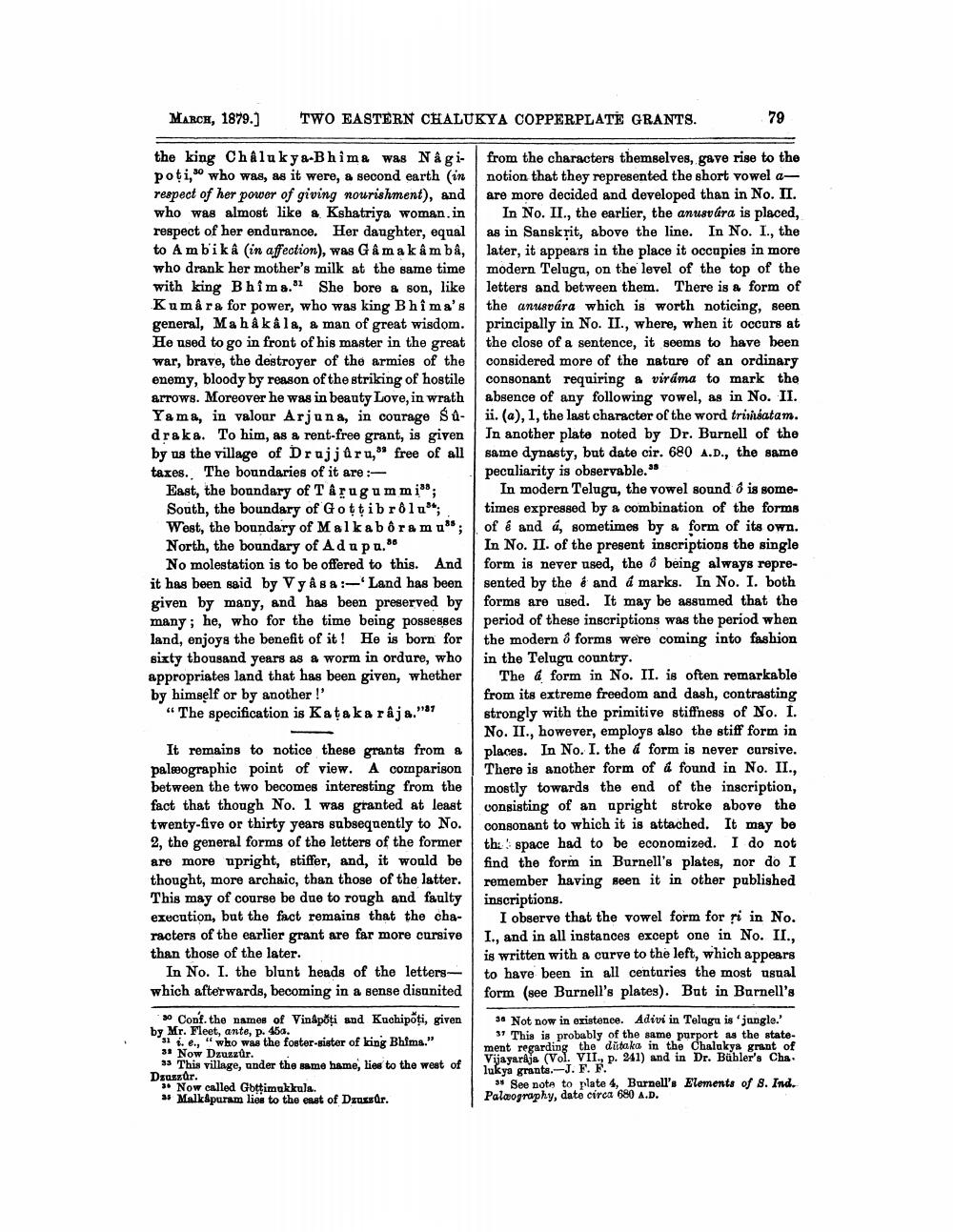________________
MARCH, 1879.)
TWO EASTERN CHALUKYA COPPERPLATE GRANTS.
79
the king Chåluk ya-Bhima was Nagi- from the characters themselves, gave rise to the poti,so who was, as it were, a second earth in notion that they represented the short vowel arespect of her power of giving nourishment), and are more decided and developed than in No. II. who was almost like a Kshatriya woman in In No. II., the earlier, the anusvára is placed, respect of her endurance. Her daughter, equal as in Sanskrit, above the line. In No. I., the to Amb'ik & (in affection), was Gâmakâm bà, later, it appears in the place it occupies in more who drank her mother's milk at the same time modern Telugu, on the level of the top of the with king Bhima. She bore & son, like letters and between them. There is a form of Kumara for power, who was king Bhima's the anusvára which is worth noticing, seen general, Maha kala, a man of great wisdom. principally in No. II., where, when it occurs at He used to go in front of his master in the great the close of a sentence, it seems to have been war, brave, the destroyer of the armies of the considered more of the nature of an ordinary enemy, bloody by reason of the striking of hostile consonant requiring a viráma to mark the arrows. Moreover he was in beauty Love, in wrath absence of any following vowel, as in No. II. Yama, in valour Arjuna, in courage su- ii. (a), 1, the last character of the word trimsatam. draka. To him, as a rent-free grant, is given In another plate noted by Dr. Burnell of the by as the village of Drajjūru, free of all same dynasty, but date cir. 680 A.D., the same taxes. The boundaries of it are :
peculiarity is observable." East, the boundary of Târugummi*; In modern Telugu, the vowel sound 8 is someSouth, the boundary of Gottib rolu; times expressed by a combination of the forms West, the boundary of Malka bôramus; of & and á, sometimes by a form of its own. North, the boundary of Adu pa.
In No. II. of the present inscriptions the single No molestation is to be offered to this. And form is never used, the 8 being always repreit has been said by Vyås & Land has been sented by the é and á marks. In No. I. both given by many, and has been preserved by forms are used. It may be assumed that the many; he, who for the time being possesses period of these inscriptions was the period when land, enjoys the benefit of it! He is born for the modern 8 forms were coming into fashion sixty thousand years as a worm in ordure, who in the Telugu country. appropriates land that has been given, whether The & form in No. II. is often remarkable by himself or by another!'
from its extreme freedom and dash, contrasting “The specification is Kataka raja.87
strongly with the primitive stiffness of No. 1.
No. II., however, employs also the stiff form in It remains to notice these grants from a places. In No. I. the á form is never cursive. paleographic point of view. A comparison There is another form of a found in No. II., between the two becomes interesting from the mostly towards the end of the inscription, fact that though No. 1 was granted at least consisting of an upright stroke above the twenty-five or thirty years subsequently to No. consonant to which it is attached. It may be 2, the general forms of the letters of the former th: space had to be economized. I do not are more upright, stiffer, and, it would be find the form in Burnell's plates, nor do I thought, more archaic, than those of the latter. remember having seen it in other published This may of course be due to rough and faulty inscriptions. execution, but the fact remains that the cha- I observe that the vowel form for ri in No. racters of the earlier grant are far more cursive | I., and in all instances except one in No. II., than those of the later.
is written with a curve to the left, which appears In No. I. the blunt heads of the letters- to have been in all centuries the most usual which afterwards, becoming in a sense disunited form (see Burnell's plates). But in Barnell's
30 Cont. the names of Vinapoți and Kuchipőți, given 36 Not now in existence. Adivi in Telugu is 'jungle.' by Mr. Fleet, ante, p. 458. Sie, who was the foster-sister of king Bhima."
31 This is probably of the same purport as the state. 31 Now Dzuzzûr.
ment regarding the dutaka in the Chalukya grant of * This village, under the same name, lies to the west of
Vijayaraja (Vol. VII., p. 241) and in Dr. Bühler's Cha. Dzuszur.
luk ya grants.-J. F. F. ** Now called Gottimukkula.
** See note to plate 4, Burnell's Elements of 8. Ind. 35 Malkápuram lies to the east of Dzussur.
Palæography, date circa 680 A.D.
ebolator




